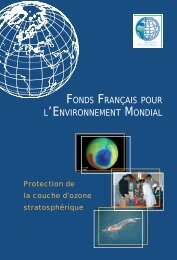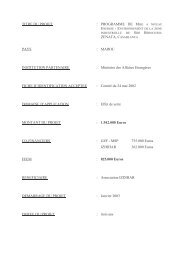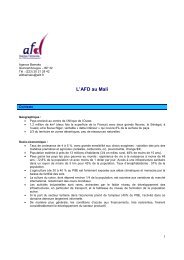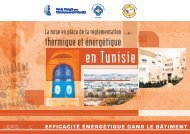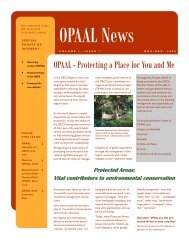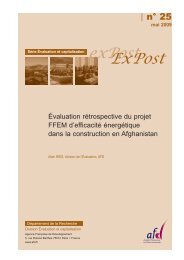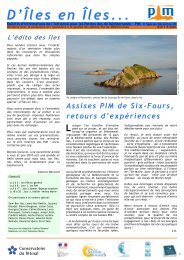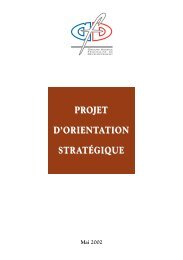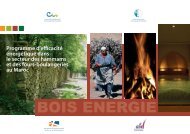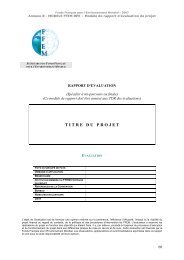SCÉNARIOS DE LA BIODIVERSITÉ AFRICAINE ... - FFEM
SCÉNARIOS DE LA BIODIVERSITÉ AFRICAINE ... - FFEM
SCÉNARIOS DE LA BIODIVERSITÉ AFRICAINE ... - FFEM
Create successful ePaper yourself
Turn your PDF publications into a flip-book with our unique Google optimized e-Paper software.
6<br />
Le Réseau des Aires Protégées d’Afrique Centrale<br />
(RAPAC) est une association sous-régionale à<br />
caractère technique et scientifique et à but non<br />
lucratif, créée en mai 2000, avec l’appui de l’Union<br />
Européenne, dans le cadre du programme ECOFAC.<br />
Il a pour mission de contribuer à la conservation et à<br />
la valorisation de la biodiversité par l’aménagement<br />
et la gestion des zones bénéficiant d’un statut de<br />
protection, en prenant en compte la satisfaction des<br />
besoins des populations riveraines. Depuis février<br />
2005, le RAPAC est mandaté par la Commission<br />
des Forêts d’Afrique Centrale (COMIFAC), pour<br />
mettre en œuvre l’axe 4 du Plan de Convergence<br />
relatif à la conservation et valorisation de la<br />
biodiversité, notamment par l’harmonisation des<br />
politiques, législations et institutions relatives<br />
aux aires protégées et l’amélioration de la qualité<br />
de leur gestion technique. L’action du RAPAC<br />
s’étend sur les pays de la CEMAC et de la CEEAC<br />
en général, en particulier les huit pays membres<br />
du RAPAC (Cameroun, Congo, Gabon, Guinée<br />
Équatoriale, République Centrafricaine, République<br />
Démocratique du Congo, Sao Tomé et Principe et<br />
Tchad.)<br />
Le programme ECOFAC V (Écosystèmes Fragilisés<br />
d’Afrique Centrale), de 2011 à mi 2015, reste financé<br />
par la Commission Européenne, avec la CEEAC<br />
Maître d’Ouvrage. Il intègre les efforts de conservation<br />
à ceux du développement par un rapprochement<br />
avec d’autres programmes financés par<br />
la Commission Européenne et d’autres bailleurs de<br />
fonds, en vue d’amplifier leurs résultats respectifs en<br />
terme de viabilité, concourant au maintien de la biodiversité,<br />
la lutte contre le changement climatique<br />
ainsi que contre la pauvreté.<br />
The Central African Protected Areas Network<br />
(RAPAC) is a sub-regional technical and scientific<br />
non-profit association, created in May 2000, with<br />
the support of the European Union, within the<br />
ECOFAC framework. Its mission is to contribute to<br />
the conservation and enhancement of biodiversity<br />
through the development and management<br />
of areas receiving protection status, taking into<br />
account the needs of local populations. Since<br />
February 2005, the RAPAC is mandated by the<br />
Commission of Central Africa Forests (COMIFAC),<br />
to implement axis 4 of the Convergence Plan for<br />
the conservation and enhancement of biodiversity,<br />
including the harmonization of policies, laws<br />
and institutions related to protected areas and<br />
the improvement of the quality of their technical<br />
management. RAPAC’s activity concerns the<br />
countries of the CEMAC and CEEAC in general,<br />
and in particular the eight members of the ACPC<br />
(Cameroon, Congo, Gabon, Equatorial Guinea,<br />
Central African Republic, Democratic Republic of<br />
Congo, Sao Tome, and Principe and Chad.)<br />
From 2011 to mid-2015, ECOFAC V programme<br />
(Weakened Ecosystems of Central Africa) remains<br />
funded by the European Commission, with CEEAC<br />
managing. It integrates conservation efforts to<br />
development by reaching out to other programmes<br />
funded by the European Commission and other<br />
partners, in order to amplify their outcomes in<br />
terms of viability, sustainability of biodiversity, fight<br />
against climate change, and against poverty.<br />
= www.rapac.org




